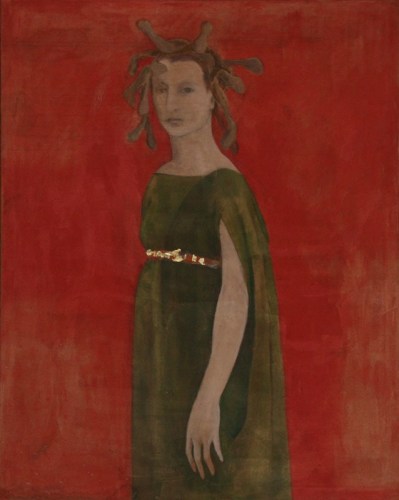
New York artist Marcia Marcus (b. 1928) emerged mid-century as a promising painter of portraits and figurative tableaux, depicting herself, friends, and acquaintances in scenes that often have a mythological or theatrical feel. In the early 1950s, she studied painting at Cooper Union, where her peers included Alex Katz and Lois Dodd, and shortly thereafter attended the Art Students League, where she absorbed the lessons of Edwin Dickinson. She collaborated on Happenings with Allan Kaprow and, in 1960, showed a series of self-portraits at the Delancey Street Museum, an alternative space run by Red Grooms. Despite an impressive exhibition record and a peer group of downtown luminaries, Marcus eventually fell into obscurity. The recent show at Eric Firestone included twenty-four paintings she made between 1958 and 1973, amounting to a small-scale retrospective for this audacious and fascinating artist.
The first painting one encountered was Medusa, a self-portrait from 1958 in which Marcus portrays herself in a form loosely resembling that of the Greek monster. Rendered against a thinly painted crimson background, and wearing an olive-green tunic and a belt embellished with bits of gold leaf, she stares out from the picture, her face framed by thick tendrils of hair. The following year, Marcus painted Self-Portrait with Tights, in which she appears as a harlequin or acrobat, posing in mustard-colored tights with her arm outstretched, the floor below her a collage of multicolored marbled endpapers. These early self-portraits hint at the narrative, allegorical possibilities Marcus would explore more fully in her complex, multi-figure compositions from the 1960s and ’70s.
In 1961, Marcus traveled to Florence and immersed herself in Byzantine and fresco painting. Florentine Landscape (1961), which measures nearly eight feet wide, is a masterpiece from this period. The setting is a barren walled garden. In the lower foreground, along the bottom edge of the composition, is a man (Red Grooms) posed coyly on his side, his head propped on his hand. In the distance behind him are a woman in a pale blue tunic and, eerily loitering at the garden’s edge, a figure whose head is covered by a black hood and who holds a white flag. The image, with its surreal atmosphere and the figures’ costumes and poses, suggests a contemporary take on commedia dell’arte.
Frieze: The Porch (1964) is a sprawling, eleven-foot-wide canvas that features three female figures: performance and dance critic Jill Johnston wearing a burgundy bowler hat, painter Barbara Forst, and Marcus in a billowing patterned cloak. At one side of the composition, a grisaille image (painted from a family photograph) shows Marcus as a child standing with her father. Each of the figures in Frieze seems self-contained, possessed by a burning interiority.
Marcus generally depicted her subjects from life, sketching them onto the canvas before painting them, and the sitters almost always meet the viewer’s gaze. The sense of awareness and directness seems to carry an almost political charge, not least in the many images of women and people of color, given the civil rights struggles taking place when the works were made. Anna (1973) is a nearly full-length portrait of an elegant, powerful African American woman in a scarlet gown seen in profile, her eyes fixed in a knowing stare. In such paintings, Marcus conveys the complex psychological character of her subjects, producing remarkably frank images in which each figure is given a distinct identity and a sense of agency.